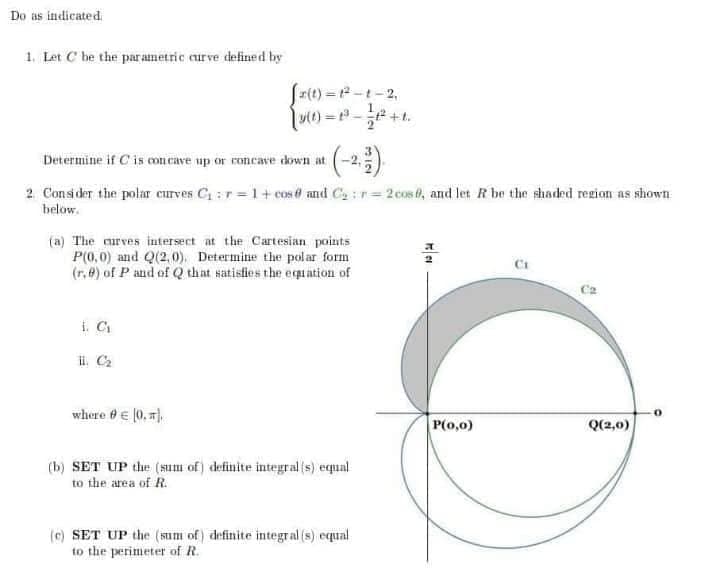1. Let C be the parametric curve defined by Determine if C is concave up or concave down at fa(t)=1²-1-2, 312 +1.
1. Let C be the parametric curve defined by Determine if C is concave up or concave down at fa(t)=1²-1-2, 312 +1.
Algebra & Trigonometry with Analytic Geometry
13th Edition
ISBN:9781133382119
Author:Swokowski
Publisher:Swokowski
Chapter11: Topics From Analytic Geometry
Section11.4: Plane Curves And Parametric Equations
Problem 31E
Related questions
Question

Transcribed Image Text:Do as indicated
1. Let C be the parametric curve defined by
fr(t)=1²-1-2₁
(v(t)=P-1 P² +1.
Determine if C is con cave up or concave down at
2. Consider the polar curves C₁=1+ cos@ and Cr=2 cos, and let R be the shaded region as shown
below.
H
(a) The curves intersect at the Cartesian points
P(0,0) and Q(2,0). Determine the polar form
(r.) of P and of Q that satisfies the equation of
1. C₁
ii. C₂
where # € [0.),
Q(2,0)
(b) SET UP the (sum of) definite integral (s) equal
to the area of R.
(c) SET UP the (sum of) definite integral (s) equal
to the perimeter of R.
P(0,0)
Expert Solution
This question has been solved!
Explore an expertly crafted, step-by-step solution for a thorough understanding of key concepts.
Step by step
Solved in 2 steps

Recommended textbooks for you

Algebra & Trigonometry with Analytic Geometry
Algebra
ISBN:
9781133382119
Author:
Swokowski
Publisher:
Cengage

Algebra & Trigonometry with Analytic Geometry
Algebra
ISBN:
9781133382119
Author:
Swokowski
Publisher:
Cengage